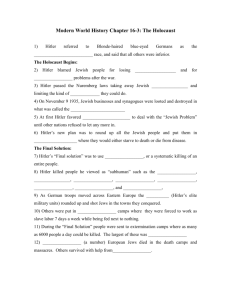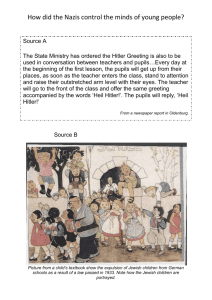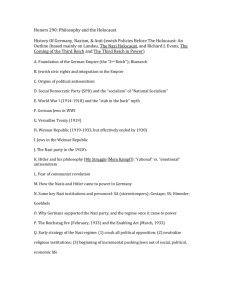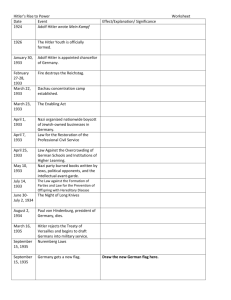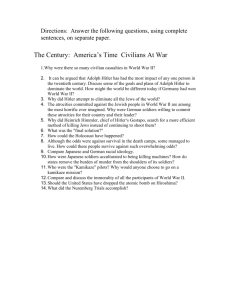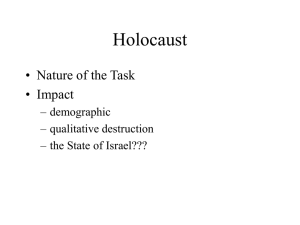January 30, 1933 Hitler becomes Chancellor, even though over 70
advertisement
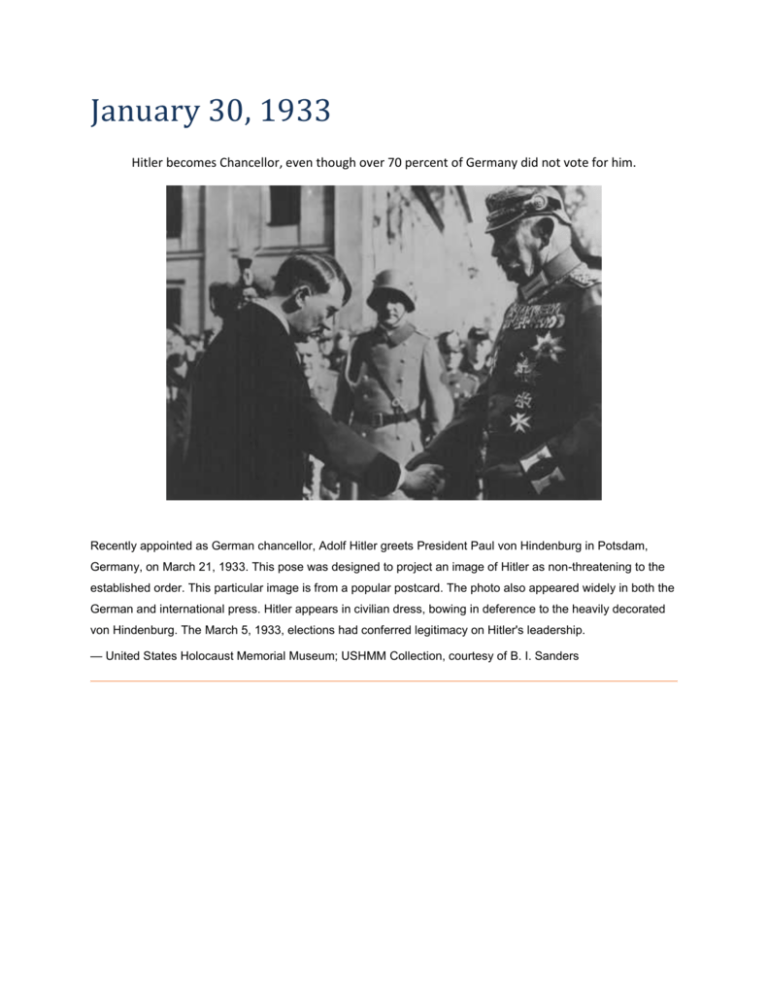
January 30, 1933 Hitler becomes Chancellor, even though over 70 percent of Germany did not vote for him. Recently appointed as German chancellor, Adolf Hitler greets President Paul von Hindenburg in Potsdam, Germany, on March 21, 1933. This pose was designed to project an image of Hitler as non-threatening to the established order. This particular image is from a popular postcard. The photo also appeared widely in both the German and international press. Hitler appears in civilian dress, bowing in deference to the heavily decorated von Hindenburg. The March 5, 1933, elections had conferred legitimacy on Hitler's leadership. — United States Holocaust Memorial Museum; USHMM Collection, courtesy of B. I. Sanders March 22, 1933 The first concentration camp, Dachau, was established. Political prisoners were imprisoned here at first. An early view of the Dachau concentration camp. Columns of prisoners are visible behind the barbed wire. Dachau, Germany, May 24, 1933. — KZ Gedenkstaette Dachau April 1, 1933 Hitler announces a state boycott of all Jewish businesses…on a Saturday. It was a failure. Members of the Storm Troopers (SA), with boycott signs, block the entrance to a Jewish-owned shop. One of the signs exhorts: "Germans! Defend yourselves! Don't buy from Jews!" Berlin, Germany, April 1, 1933. — National Archives and Records Administration, College Park, Md. May 10, 1933 All over Germany, books by Jewish, handicapped, and “undesirable” authors are burned. At Berlin's Opernplatz, an SA man throws books into the flames at the public burning of books deemed "unGerman." Berlin, Germany, May 10, 1933. — United States Holocaust Memorial Museum June 30, 1934 The Night of the Long Knives. Over 300 people on Hitler’s hit list were murdered, many of them Hitler’s own military. Political opponents of the Nazis, guarded by SA (Storm Troopers), are forced to scrub anti-Hitler slogans off a wall shortly after the Nazi assumption of power. Germany, March 1933. — Archiv der Sozialen Demokratie der Friedrich-Ebert-Stiftung September 10, 1935 Nuremberg Laws are released. These laws deprive the Jews of basic rights, such as citizenship and the right to marry whomever they would like. Chart illustrating the Nuremberg laws. The figures represent Germans, Jews, and Mischlinge. Germany, 1935. — Stadtarchiv und Landesgeschichtliche Bibliothek Bielefeld August 1-6, 1936 The Olympics in Berlin. Hitler establishes the torch run from Greece. Jesse Owens from American sets major world records. German citizens saluting Adolf Hitler at the opening of the 11th Olympiad in Berlin. [ALSO HAVE OVERSIZED PRINT] Date: Aug 1936 Locale: Berlin, [Berlin] Germany; Berlin-Buckow; Berlin-Mariendorf; Berlin-Ochstumsand; Berlin-Ploetzensee; Berlin-Reinickendorf; Berlin-Tempelhof; Berlin-Wannsee; Berlin-Schlachtensee; Berlin-Duppel Credit: United States Holocaust Memorial Museum, courtesy of National Archives and Records Administration, College Park Copyright: Public Domain July 1938 World leaders met in Evian, France to discuss what to do about Hitler. They decided to do nothing. Myron Taylor represented the United States. United States delegate Myron Taylor delivers a speech at the Evian Conference on Jewish refugees from Nazi Germany. Evian-les-Bains, France, July 15, 1938. — National Archives and Records Administration, College Park, Md. October 1938 Deportations of Jews to other countries begin. Hitler’s first idea was to just get them out of Germany. German Jews from the town of Coesfeld are assembled for deportation to Riga, Latvia. Locale: Coesfeld, Germany Photographer: Anton Walterbusch Credit: United States Holocaust Memorial Museum, courtesy of Fred Hertz Copyright: United States Holocaust Memorial Museum November 7, 1938 In response to a letter from his parents, who were deported from Germany, Herschel Grynzpan assasinated Ernst Vom Rath in the German embassy in Paris. He was arrested and killed. Portrait of Herschel Grynszpan taken after his arrest by French authorities for the assassination of German diplomat Ernst vom Rath. Grynszpan (1921-1943?), born in Hannover, Germany, was the son of Polish Jews who had immigrated to Germany. In 1936 Grynszpan fled to Paris. On November 7, 1938, after having learned of the deportation of his parents from Germany to the Polish frontier, Grynszpan assassinated Ernst vom Rath, the third secretary of the German embassy in Paris. The diplomat's subsequent death two days later was used by the Nazi regime as justification for unleashing the Kristallnacht pogrom of November 9-10. In 1940 Grynszpan was turned over to the Germans by the Vichy government, but the date and place of his death have never been clarified. Paris, France, November 7, 1938. — USHMM, courtesy of Morris Rosen November 9-10, 1938 In a nationwide pogrom called Kristallnacht, the Nazis and their collaborators burn synagogues and loot Jewish homes and businesses. Approximately 30,000 Jewish men are imprisoned in concentration camps such as Dachau. The Boerneplatz synagogue in flames during Kristallnacht (the "Night of Broken Glass"). Frankfurt am Main, Germany, November 10, 1938. — Bildarchiv Preussischer Kulturbesitz May 1939 The S.S. St. Louis left Germany, bound for Cuba. The Cubans and the Americans refused to let them in and they had to go back to Europe. Group portrait of children on the deck of the SS St. Louis. Pictured in the front row, from left to right are: Herbert Karliner, Harry Guttmann, Hans Schelansky. In the second row: Eugene Moser, unknown, Erich Stein, Walter Karliner and Hans Fischer. September 1, 1939 In response to a fake attack on a border radio station, Hitler invaded Poland and begins World War II. No one came to Poland’s defense. The Nazis execute Polish leaders and change education. The Soviets also invade from the East and they divide Poland between them. Adolf Hitler (standing at front of car) enters Danzig. The Danzig District was incorporated into Greater Germany following the invasion of Poland. Danzig, September 19, 1939. — National Archives and Records Administration, College Park, Md. October 1939 The T-4 Euthanasia Program begins in Germany. Those in mental institutions are used as guinea pigs for experiments with lethal injection and gas. This is how the Nazis discover Zyklon B gas. Buses used to transport patients to Hadamar euthanasia center. The windows were painted to prevent people from seeing those inside. They often used these buses as gas vans, re-routing the exhaust into the back and driving around town until the patients were dead. Germany, between May and September 1941. — Hessisches Hauptstaatsarchiv Wiesbaden Summer 1941 Killing squads called the Einsatzgruppen begin going into towns and killing all Jews in large numbers with machine guns. Hundreds of thousands are killed this way. Members of an Einsatzkommando (mobile killing squad) before shooting a Jewish youth. The boy's murdered family lies in front of him; the men to the left are ethnic Germans aiding the squad. Slarow, Soviet Union, July 4, 1941. — Dokumentationsarchiv des Oesterreichischen Widerstandes December 7, 1941 The Japanese attack Pearl Harbor, bringing the United States into the war. Smoke billows out from U.S. ships hit during the Japanese air attack on Pearl Harbor. Date: Dec 7, 1941 Locale: Honolulu, HI United States Credit: United States Holocaust Memorial Museum, courtesy of National Archives and Records Administration, College Park Copyright: Public Domain January 20, 1942 The Wannsee Conference takes place in a house outside of Berlin. Here, top Nazi officials decide the fate of the Jews: The Final Solution. Site of the January 1942 Wannsee Conference, convened by Reich Security Main Office chief Reinhard Heydrich, on the "Final Solution to the Jewish Question." Wannsee, Germany, date uncertain. — Ullstein Bilderdienst Summer 1942 Deportations from ghettoes to killing centers and concentration camps begin. Jews during a deportation from the Warsaw Ghetto. Date: Oct 1940 - May 1943 Locale: Warsaw, Poland; Varshava; Warschau Credit: United States Holocaust Memorial Museum, courtesy of Leopold Page Photographic Collection Copyright: Agency Agreement (No Fees) April-October 1943 Jews begin to rebel and fight back once they learn what the Nazis have waiting for them in the killing centers and camps. Members of a Jewish resistance group (Organisation Juive de Combat). Espinassier, France, wartime. — La Documentation Francaise December 1944 Death marches from the camps begin. The survival rate on a march was one in every five people survived. A view of the death march from Dachau passing through villages in the direction of Wolfratshausen. German civilians secretly photographed several death marches from the Dachau concentration camp as the prisoners moved slowly through the Bavarian towns of Gruenwald, Wolfratshausen, and Herbertshausen. Few civilians gave aid to the prisoners on the death marches. Germany, April 1945. — KZ Gedenkstaette Dachau January-May 1945 The Allies liberated the killing centers and concentration camps, places they didn’t know even existed until they stumbled on them. Former prisoners of the "little camp" in Buchenwald stare out from the wooden bunks in which they slept three to a "bed." Elie Wiesel is pictured in the second row of bunks, seventh from the left, next to the vertical beam. Abraham Hipler is pictured in the second row, fourth from the left. The man on the third bunk from the bottom, third from the left, is Ignacz (Isaac) Berkovicz. [He has also been identified as Abraham Baruch.] Michael Nikolas Gruner, originally from Hungary, is pictured on the bottom left corner. Perry Shulman from Klimitov, Poland is on the top bunk, second from the left (looking up). Buchenwald, Germany, April 16, 1945. — National Archives and Records Administration, College Park, Md.; United States Holocaust Memorial Museum April 30, 1945 Hitler commits suicide in his bunker in Berlin. He had just married his secretary an hour before his death. She also committed suicide. Soviet soldiers guard the entrance to Hitler's underground bunker. Upon the advance of Soviet forces through the streets of Berlin, Hitler committed suicide here on April 30, 1945, rather than face capture. Berlin, Germany, 1945. — Wide World Photo May 8, 1945 The Germans surrendered and World War II is over in Europe. The Japanese do not surrender until August. German officers surrender in Paris. France, August 1944. — The Paris Pages, "Paris Libere!" -- www.paris.org -- Norman H. Barth

